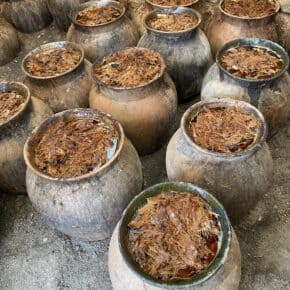Often described as a goddess of fertility, Mayahuel also is regarded as the goddess of Agave because of the origin story and how she has been depicted in the primary Mexican codices perched on agave. The name Mayahuel comes from the Nahuatl words metl meaning “maguey” and yohualli meaning “round” or “encircling”, which could roughly translate to “one who surrounds the maguey”. It is unclear exactly whether the Otomi, Huastec or Olmec, ancient Mesoamerican empires, birthed the story of Mayahuel and there are a few versions to the myth.
One is about the origin of pulque and involves two characters: one is Mayahuel as a woman, the first who made aguamiel from the sap of the agave. In order to have done this she would have needed to know the plant as well as the process of removing the quiote and scraping the inside to get the sap out. She is seen as Patécatl’s husband, the creator of octli which is the medicine of pulque. Their divine knowledge of getting the aguamiel and fermenting it, led to them being granted the goddess and god standing. Their sons are known as Centzontotochtin or the 400 rabbits (Tepoztecatl, Cuatlapanqui, Tliloa and Papaztac among others) who are also recognized as minor deities that represent the different states of drunkenness.
The second story is the most popular since it is related to the agave plant creation. A virgin goddess who lived in the cosmic heaven wished to travel to Earth. Ehécatl-Quetzalcoatl, the God of wind, aware of her wish, went to see her to make the trip together and they once arrived on Earth, they fell in love and were transformed into two flowering and intertwined trees. When her sisters and grandmother, known as the Tzitzimime, heard of their journey to earth, they went in search of them. When they found her, she had transformed into a plant and they ripped her from Quetzalcoatl’s tree. After breaking her into pieces, the Tzitzimime ate her. Quetzalcoatl returned to his original shape, picked up the remaining pieces and then buried them. Because Quetzalcoatl was aware of the human need to enjoy life, he wanted them to have joy in their hearts and to remember Mayahuel, he transformed her into a plant with 400 breasts or leaves.
Both versions correspond to Mayahuel’s nature and are complementary one to the other. There have been recent investigations into the actual origins of Mayahuel, which we detail in this piece – Is Mayahuel by any other name still Mayahuel?












Leave a Comment